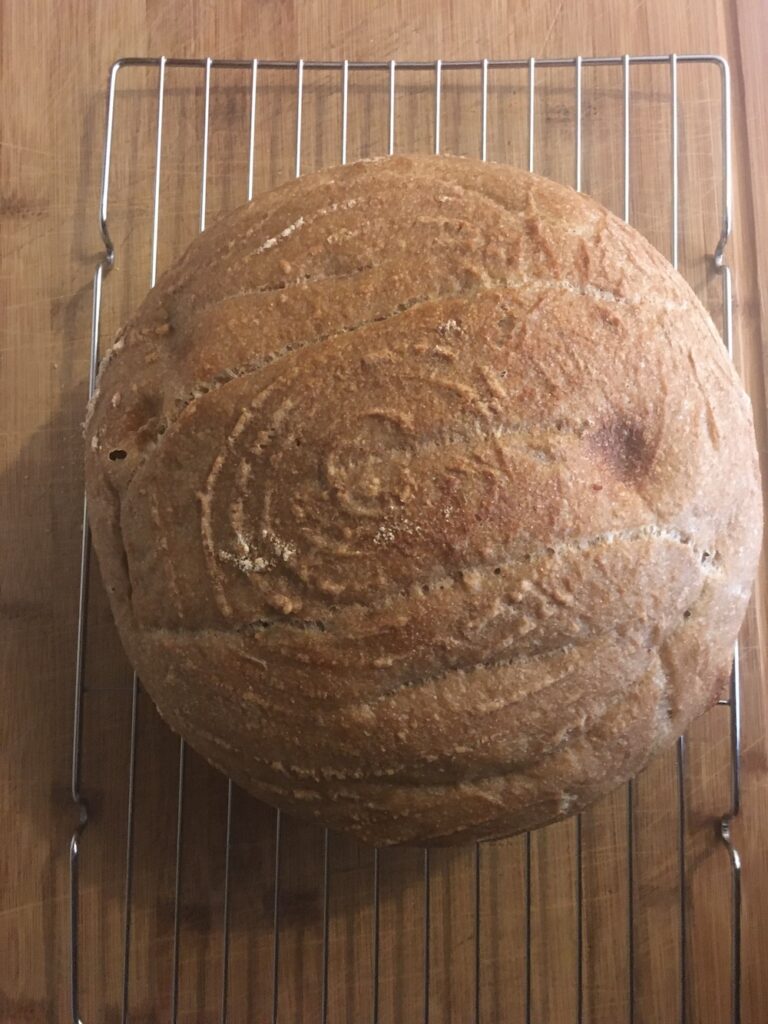Sourdough can be overwhelming and really requires patience. Seriously, it took me like 20 times before I even followed all the steps of the boule recipe. So if you’re just starting out, I’d really recommend getting some easy success with this first recipe before you go on to the more intensive (and more delicious) boule recipe below.
Easy Overnight Sourdough Bread
This recipe was copied from this Weston A Price foundation post.
INGREDIENTS
- 2 cups organic unbleached all-purpose flour
- 2 cups organic sprouted whole wheat flour
- 1 cup fresh sourdough starter
- 1/4 cup coconut oil
- 1/4 cup raw honey
- 1 1/2 cups filtered water
- 2 tsp unrefined sea salt
INSTRUCTIONS
- Add sourdough starter to mixing bowl. Add water and sprouted whole wheat flour. Stir to combine. Add all-purpose flour, salt, honey and coconut oil to bowl. (You can omit the organic unbleached all-purpose flour and use 2 additional cups of organic sprouted whole wheat flour instead.)
- Tip: Use coconut oil in measuring cup first. Then use the same cup for the honey. The remaining coconut oil will keep the honey from sticking and will make it easier to add.
- Attach dough hook to mixer and mix to combine. The dough should be pulling away from the sides of the bowl and not sticky. If it is sticky, add a bit of flour, 1/4 cup at a time until it pulls away from the bowl.
- Now it’s time to let it sit and let the starter do its work. Place the dough in a cast iron dutch oven that has been greased with coconut oil. Place the top on the dutch oven and let it sit overnight. Or you can place this in the refrigerator and let it stay until you are ready to bake. If you place in the refrigerator, be sure to remove it 2 hours before you plan to bake it so it can come to room temperature and rise a bit.
- In the morning, set oven temperature to 425°F. When the oven is ready, place the entire dutch oven with the lid on into the oven and bake for 30 minutes. After 30 minutes, remove the top and bake an additional 15 minutes.
- Take out of the oven and remove the bread to a cooling rack.
- Serve with butter, as a side to soups or use as sandwich bread and enjoy!
Now this recipe makes for a decent bread. And for most, it could be good enough. But we’re bread bougie in my house, and this slightly chewy “dessert” bread (as Lev was calling it) wasn’t really hitting it for us.
So after a few successes with this, I went on to the big kid’s pool and dived in to make this beauty pictured here.
And when I say dive, I really mean slow and slightly painful tread – like I said before it took me about 20 times before I even did all the steps in the recipe. Let alone start adjusting it to my own preferences.

Whole Wheatish Boule Recipe
This recipe is based on Butter for All’s boule recipe – with my own numbers to increase the whole wheat to our family’s preference.
Prep Time
1 d
Cook Time
40 mins
Total Time
1 d 40 mins
Ingredients
- 475 Grams Organic Bread Flour
- white
- 125
- wheat
- 250
- sprouted whole wheat
- 100
- white
- 325 Grams Filtered Water
- 250 Grams Active Sourdough Starter
- 10 Grams Sea Salt
Instructions
- Weigh all ingredients into a glass or ceramic bowl.
- Mix the ingredients into a loose shaggy dough with a wooden spoon or dough whisk.
- Wet your hands and gently knead the dough in the bowl by hand until it comes together with no excess flour.
- Let the dough rest covered for 10-15 minutes.
- Start the first stretch and fold by wetting your hands and lifting one side of the dough and folding it toward the middle. Repeat this stretch and fold process in all four directions.
Sometimes you can get away with an extra one or two folds depending on the elasticity of the dough. If it wants to stretch, stretch it! If it’s tearing or breaking it needs a rest! - Let the dough rest for 10 minutes.
- Start the second stretch and fold by wetting your hands and repeating the same folding motion in (at least) all four directions.
- Let the dough rest for 10 minutes.
- Repeat the stretch and fold and resting process up to 5 more times for a total of 7 stretch and folds (or as many as you are able). I have made great bread by just just doing two stretch and folds. But remember, the more stretching and folding, the more gluten will develop, and the higher your bread will rise!
- After the last stretch and fold cover the dough and allow it to double in size. This can take anywhere from 3-6 hours depending on starter strength and ambient temperature.
- Prepare your banneton (proofing basket) with a coating of flour. My trick is to use sprouted wheat flour. Sprouted wheat does not develop gluten so it will keep the bread from sticking to the basket. Rice flour, buckwheat or other non glutenous flour can also be used.
- Working with the doubled dough, start the final stretch and fold. This will act as the “punch down” of the dough, deflating the gasses trapped inside the gluten network. Stretch the dough several times toward the center, each time pressing down on the dough to remove air bubbles.
- Let the dough rest for 10 minutes.
- Lightly wet your hands and remove the dough from the proofing bowl onto your work surface. Shape the dough by repeating the same folding toward the center action. Once a tight ball is achieved flip it seam side down and push it gently in all directions across the work surface to build tension in the outer layer. (please see attached video)
- Let the dough rest seam side down for 5 minutes.
- Transfer the dough to the banneton basket. This time you want the seam to be up and the tight surface to be down in the basket.
- Sprinkle the seam side of the shaped dough with a light dusting of flour and cover it securely with wrap and a rubber band.
- Place the banneton basket in the refrigerator overnight for at least 10 hours. 12-24 hours is my preferred proofing time.
- Once the dough has crested the edge of the banneton it is ready to bake. But you may keep it in the refrigerator for a longer period of time.
- Preheat your oven to 450° with your covered Dutch oven inside!
- Cut a piece of parchment paper big enough to overhang your loaf’s circumference by a few inches.
- Remove the banneton from the refrigerator, remove the wrap from the dough and place the parchment sheet over the exposed dough (Note from Ife – I don’t use parchment paper. I just puck it up with my hands and throw it into the dutch oven when it’s time. It’s risky business, but it works out alright.) Hold the parchment in place with your hand while you flip the dough onto the counter. Now the parchment is on the bottom.
- Carefully ease the banneton off the dough. Sometime it takes a little coaxing. Use your fingers to gently work between the dough and basket. Hopefully the basket will lift away clean!
- Using a sharp razor blade, score the dough along the top. There are so many scoring patterns to practice with, but a good one to start with is a simple slash or a cross. Score the dough about 1/2 inch deep.
- Using baking gloves remove the Dutch oven from the oven and remove the lid.
- Working quickly pick up the boule by the parchment paper edges and place it into the Dutch oven on top of the parchment.
- If desired add a few ice cubes to the Dutch oven between the parchment and the wall of the Dutch oven, or spray the boule with a few spritzes of filtered water. Adding additional moisture will keep the crust soft allowing for more rise and give a nice blistered texture and appearance.
- Cover the Dutch oven and place it back in your preheated oven. Bake undisturbed for 25 minutes!
- Open your oven and remove the Dutch oven lid. Bake an additional 15 minutes!
- Remove your Dutch oven from the oven and gently lift the boule out using the parchment paper as handles. Remove the parchment paper and cool the boule on a wire rack. Cool the boule completely before cutting (possibly the hardest part of baking this incredible loaf of bread!).
So yea, try ’em out and let me know how it turns out. And if you need any support further, Butter for All has a great blog post called Demystifying Sourdough that’s pretty informative (though still, a bit complicated and I feel a little extra for those of us who just want to make some bread real quick and now like works of art. lol) And let me know if you’d like some support from me too, I’m no professional, but I’ve been making bread for a minute now and I like math – and that’s really all this is, a bunch of math and patience, lol.
Thanks for reading!


